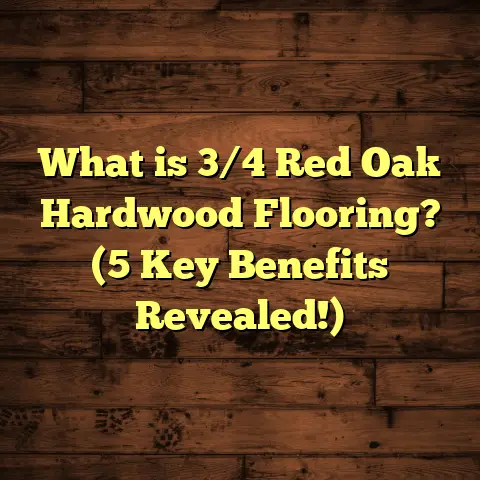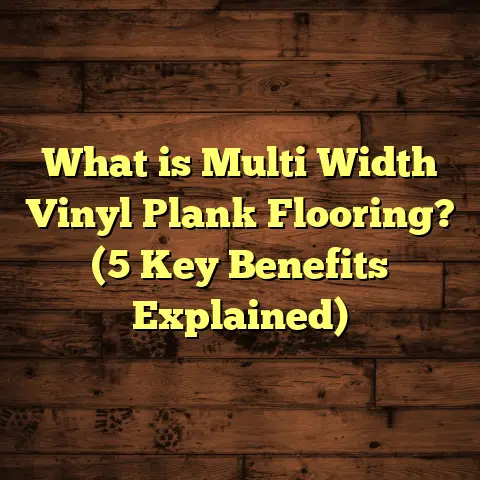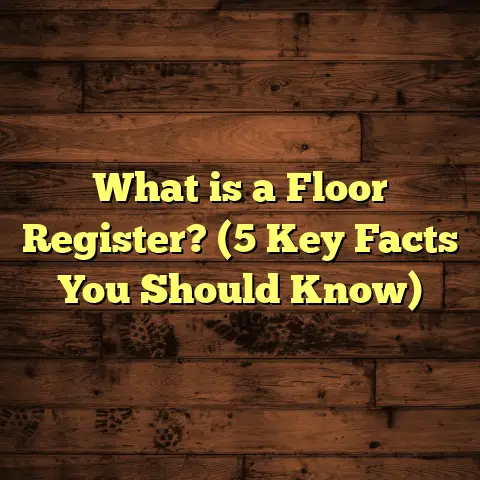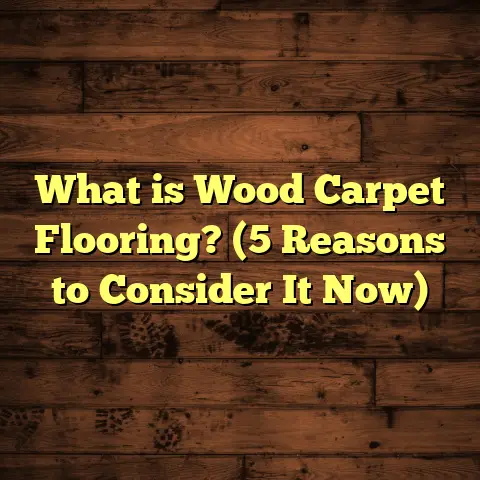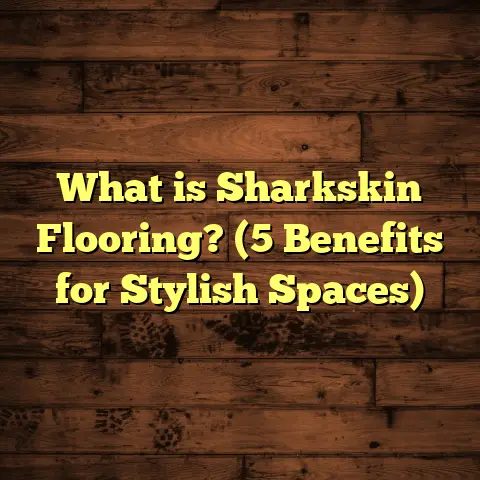What is a Floating LVT Floor? (5 Key Benefits for Your Home)
I still remember the day I decided to replace the old, worn-out flooring in my living room. The hardwood was scratched, and the finish was dull. I wanted something durable, easy to install, and visually appealing but didn’t want to spend a fortune or deal with a lengthy renovation. I had no idea what to choose at first — hardwood? Tile? Laminate? The options felt endless and confusing. Then I stumbled on something called “floating LVT flooring.” It sounded interesting but a bit unfamiliar. After digging deeper and eventually installing it myself, I realized how versatile and practical this option is for many homeowners like me. If you’re curious about what floating LVT floors are and why they might be perfect for your home, I’d love to share everything I’ve learned.
What Is a Floating LVT Floor?
So, what exactly is floating LVT flooring? Let’s break it down step by step.
LVT stands for Luxury Vinyl Tile. It’s a type of vinyl flooring that has come a long way from the basic vinyl sheets you might remember from decades ago. LVT is designed to look like natural materials such as wood, stone, or ceramic tile but with greater durability and ease of maintenance. The surface layer is printed and textured to create realistic patterns—whether that’s the grain of oak wood or the veins in marble.
Now, “floating” refers to how the floor is installed. Unlike traditional flooring that’s nailed or glued down, floating floors are assembled plank by plank over the existing floor without attaching directly to the subfloor below. The planks snap or click together with a locking system, creating a stable surface that essentially “floats” above the ground.
This method has some big advantages: no messy glue, no nails, and it can often be installed over existing flooring like concrete slabs, plywood, or even old vinyl. The floor isn’t permanently fixed down, which means it can expand and contract slightly with changes in temperature and humidity without damage.
How Does Floating LVT Compare to Other Flooring Types?
You might be wondering how floating LVT stacks up against hardwood, laminate, or tile floors you hear about all the time.
- Hardwood: Real wood floors are beautiful but pricey and require regular maintenance like refinishing. They’re also sensitive to moisture.
- Laminate: Laminate mimics wood using fiberboard with a photographic layer on top. It’s cheaper but can’t handle water well.
- Tile: Tile is durable and waterproof but cold and hard underfoot.
- Sheet Vinyl: Cheaper but less realistic-looking and often less durable.
Floating LVT combines many benefits: it looks great, resists water and scratches well, feels softer than tile, and can be installed quickly without professional help.
Why Did I Choose Floating LVT for My Home?
Back when I was researching flooring options, I was overwhelmed by choices: hardwood, laminate, tile, carpet… but none felt quite right. Hardwood was pricey and required maintenance; laminate lacked warmth; tile was cold and tough on the feet. Floating LVT struck a perfect balance.
Here’s what convinced me:
- Ease of installation: I’m not a professional contractor, but the click-lock system made it doable as a DIY project.
- Durability: Living with kids and pets means floors take a beating. LVT promised resistance to scratches, stains, and moisture.
- Aesthetic flexibility: I could choose from hundreds of styles and colors.
Since then, I’ve installed floating LVT in two more rooms and even advised friends on their flooring projects.
5 Key Benefits of Floating LVT Flooring for Your Home
1. Easy and Fast Installation Saves Time and Money
One of the biggest advantages I experienced firsthand was how quickly the floor went down. Because floating LVT requires no glue or nails, the installation process is straightforward.
You can expect:
- Cutting the planks to size with a standard utility knife or saw
- Clicking them together like puzzle pieces
- Installing over almost any flat, clean surface — including concrete, plywood, or even existing vinyl
In my living room (about 250 square feet), it took just two days from start to finish, including prep work. Compared to traditional hardwood or tile that requires adhesive curing or grout drying time, floating LVT lets you use your room sooner.
According to industry data, professional installation of floating LVT costs about 30-40% less than hardwood flooring installation, mainly because labor hours are reduced by half.
Plus, because you can install it yourself if you want to save even more money, many homeowners find this option attractive. When I installed my first floating LVT floor, I didn’t have much experience with flooring projects. But thanks to detailed instructions and online tutorial videos from manufacturers, it was surprisingly manageable.
Tip: Before starting your installation, measure your room carefully and order about 10% extra material to cover cutting waste and mistakes.
2. Durable Surface That Handles Life’s Messes
As someone who’s dealt with pets scratching floors and kids spilling juice regularly, durability is a huge selling point for me. Floating LVT floors are made with multiple layers:
- A clear protective wear layer that resists scratches and stains
- A design layer that replicates wood grain or stone texture
- A core layer providing structural stability
Because of this construction, floating LVT can withstand heavy foot traffic without showing wear. Manufacturers often rate wear layers between 6 mil (residential use) to 20 mil (commercial-grade). For my home, I went with 12 mil thickness to balance cost and durability.
In one study by the National Wood Flooring Association, vinyl flooring had 25% higher resistance to scratches compared to traditional hardwood finishes. Plus, it’s waterproof, which means spills or accidents don’t warp the floor like real wood would.
Pets especially put floors through their paces. Scratches from claws are common on hardwood floors but tend not to show on textured LVT surfaces. Also, accidents like water spills or pet urine won’t ruin an LVT floor.
My experience: After two years living with dogs and kids running around nonstop, my floating LVT floors look nearly brand new.
3. Comfort and Warmth Underfoot
Floating LVT offers more comfort than tile or stone because it has a slight cushion effect thanks to its layered construction. Unlike ceramic tile, which feels cold and hard, LVT flooring stays warmer especially when paired with an underlayment.
I added a foam underlayment beneath my floors which reduced noise and gave the surface a soft feel when walking barefoot — something family members appreciated during chilly mornings.
The thermal insulation also helps maintain room temperature better than bare concrete or tile floors. If you’re in a colder climate or have radiant heating systems, floating LVT works well without compromising comfort.
In fact, some manufacturers design specific underlayments for floating LVT that include moisture barriers plus soundproofing qualities — perfect for multi-story homes where noise control matters.
4. Low Maintenance Without Compromising Style
I’m not a fan of spending hours cleaning floors every week. Floating LVT is one of those materials that looks great without much hassle.
Routine cleaning involves:
- Sweeping or vacuuming dirt and dust
- Damp mopping with mild detergent (no harsh chemicals needed)
- Wiping spills promptly
Because the surface is sealed and waterproof, you don’t have to worry about stains soaking in or damaging the floor. The realistic textures even hide dirt better than glossy surfaces.
A survey from Flooring America found that 87% of homeowners who switched to vinyl flooring reported satisfaction with how easy it was to maintain compared to hardwood or carpet.
One friend told me that after transitioning her kitchen from tile to floating LVT, she saved hours every month from easier cleanup.
5. Versatility and Design Options for Every Style
When picking out flooring for my house, style mattered just as much as function. Floating LVT offers an incredible variety of design options — everything from classic oak wood grain to exotic stone patterns.
Thanks to advanced printing technology, manufacturers can replicate fine details like knots in wood or veins in marble almost perfectly. This means you can get high-end looks without paying premium prices.
Additionally, because floating LVT installs over existing floors, it’s perfect for renovations where removing old tile or carpet would be costly or messy.
If you want a rustic farmhouse vibe or sleek modern finish, floating LVT has something for you.
I personally chose a weathered gray oak pattern for my living room because it complemented my furniture while hiding dirt well — a practical style choice!
Digging Deeper: Breaking Down Floating LVT Components
Understanding what goes into floating LVT floors can help you make smarter choices during purchase and installation.
Wear Layer
This is the topmost protective coating that shields your floor from scratches, scuffs, stains, and fading from sunlight exposure. The thicker this wear layer is (measured in mils), the longer your floor will last under heavy use.
Typical wear layer thicknesses:
| Use Type | Wear Layer Thickness (mils) |
|---|---|
| Residential | 6 – 12 |
| Commercial | 12 – 20 |
For homes with pets or kids where durability matters most, aim for at least 12 mil wear layer thickness.
Design Layer
This printed layer gives your floor its look — wood grain patterns, stone textures, tile designs — with photorealistic detail thanks to modern inkjet printing technology.
Core Layer
The core provides stability and impact resistance. It’s usually made from PVC vinyl composite or sometimes enhanced with fiberglass for extra strength.
Some brands offer rigid core options (WPC – Wood Plastic Composite or SPC – Stone Plastic Composite) which feel firmer underfoot and are especially good for uneven subfloors or areas with moisture concerns.
Backing Layer
This bottom layer adds balance and prevents moisture from seeping upwards from concrete slabs or basements.
Common Questions About Floating LVT Floors (From My Experience)
Can You Install Floating LVT in Bathrooms?
Absolutely! Because floating LVT is waterproof (not just water-resistant), it works well in bathrooms where spills and humidity are common. Just be sure to seal any gaps around fixtures like toilets or vanities properly to prevent water from seeping underneath long-term.
How Long Does Floating LVT Last?
With proper care, floating LVT floors can last 10-20 years in residential settings. Commercial-grade planks can last even longer depending on traffic levels.
Is Floating LVT Environmentally Friendly?
Vinyl flooring involves synthetic materials but newer products often include recycled content and can be recyclable themselves depending on manufacturer programs. Low-VOC (volatile organic compounds) certifications are common now ensuring indoor air quality safety.
Can You Repair Damaged Sections?
Because floating LVT is installed plank by plank without glue underneath (usually), damaged planks can sometimes be removed individually and replaced — though this depends on how your floor was installed. Keeping extra material from your original purchase makes repairs easier.
Installation Insights From My Projects
When I installed my floating LVT floors across various rooms over the years, I picked up several tips worth sharing:
Subfloor Preparation Is Key
No matter how great the product is, if your subfloor isn’t flat or clean, your floating floor won’t perform well long-term. I spent time leveling dips with self-leveling compound before installing planks in an older home’s basement family room.
Acclimate Flooring Before Installation
Leave your unopened boxes in the room where you’ll install the flooring for at least 48 hours before starting work. This helps planks adjust naturally to temperature and humidity levels so they expand/contract less after installation.
Leave Expansion Gaps
Vinyl expands slightly with heat changes — if you don’t leave small gaps around edges (usually 1/4 inch), boards can buckle or cup over time as they press against walls or fixed objects like cabinets.
Use Proper Tools
A tapping block helps lock planks together without damaging edges; spacers keep your expansion gaps consistent; pull bars help fit planks tight near walls easily.
Data-Backed Benefits: What Research Shows About Floating LVT Floors
To give you more confidence in choosing floating LVT flooring for your home, here are some data points from studies and industry research:
- According to a study by Freedonia Group (2022), vinyl flooring sales rose by nearly 8% annually in North America due largely to innovations like rigid core vinyl plank products.
- The National Wood Flooring Association reports vinyl floors have scratch resistance ratings up to 25% higher than traditional hardwood finishes.
- Consumer surveys by Houzz show over 70% of homeowners who switched to luxury vinyl flooring cite ease of maintenance as their primary satisfaction reason.
- Environmental Product Declarations (EPD) filed by major manufacturers indicate many vinyl products now use post-industrial recycled content up to 30%, reducing environmental footprint.
- Cost analyses reveal floating LVT installation averages $2-$7 per square foot compared with $5-$12 for hardwood or $7-$15 for ceramic tile including labor.
Real-Life Case Study: My Friend Lisa’s Kitchen Renovation
My friend Lisa wanted to update her kitchen but was worried about water damage from spills since she has two young kids. She chose floating LVT for its waterproof properties and easy cleanup.
We installed a stone-look pattern with textured surfaces for slip resistance. The project took three days including removing old linoleum.
After six months, Lisa reported zero issues with stains or scratches despite heavy use. She loves how warm the floor feels compared to her previous tile and says it changed the whole vibe of her kitchen — making it cozier yet practical.
Lisa also noted how quick cleanup became: “Spills wipe up in seconds without worrying about grout stains like before.”
Her case shows how floating LVT works well not only in living spaces but also demanding kitchens where durability plus style matter equally.
The Cost Factor: How Much Should You Expect?
Budgeting for new flooring is always a top concern. Here’s what I found based on years of projects:
| Flooring Type | Material Cost / sq ft | Installation Cost / sq ft | Total Cost / sq ft |
|---|---|---|---|
| Floating LVT | $1.50 – $4 | $1 – $3 | $2.50 – $7 |
| Hardwood | $3 – $8 | $4 – $8 | $7 – $16 |
| Laminate | $1 – $3 | $1 – $2 | $2 – $5 |
| Tile | $2 – $7 | $5 – $10 | $7 – $17 |
Floating LVT strikes a sweet spot between affordability and quality — you get realistic looks plus durability at a fraction of hardwood’s price tag.
Environmental Impact Considerations
Vinyl flooring isn’t perfect environmentally because it’s petroleum-based plastic material. However:
- Many brands now use low-VOC formulations reducing indoor air pollution.
- Some manufacturers offer recycling programs accepting old vinyl planks.
- Post-industrial recycled content reduces raw resource use.
- Vinyl’s long lifespan means less frequent replacement compared to carpet which sheds fibers into air regularly.
Choosing vinyl certified by third-party groups like FloorScore helps ensure safer indoor environments while acknowledging trade-offs inherent in synthetic materials.
More Tips Based on My Experience
Protect Your Floor With Furniture Pads
Even though floating LVT is scratch-resistant, sharp furniture legs can dent or scratch if dragged carelessly. Use felt pads under chairs and tables where possible.
Control Moisture Sources
Although vinyl is waterproof on surface level, standing water left too long near baseboards or under appliances might seep underneath if not sealed properly causing mold risk below floorboards over time.
Clean Up Spills Quickly
Waterproof doesn’t mean invincible — acids from food spills like wine or citrus juice left too long may discolor surfaces on cheaper brands lacking thick wear layers.
Final Thoughts on Floating LVT Floors
If you’re searching for a balance between style, durability, comfort, and budget-friendliness, floating LVT flooring deserves serious consideration. Its easy installation makes it great for DIYers like me while offering professional-grade performance.
From my personal experience and feedback from others who’ve installed it, floating LVT stands out as a smart choice that fits both busy family life and aesthetic goals without breaking the bank.
Got questions about floating LVT floors? I’m happy to share more tips based on what I’ve learned!
